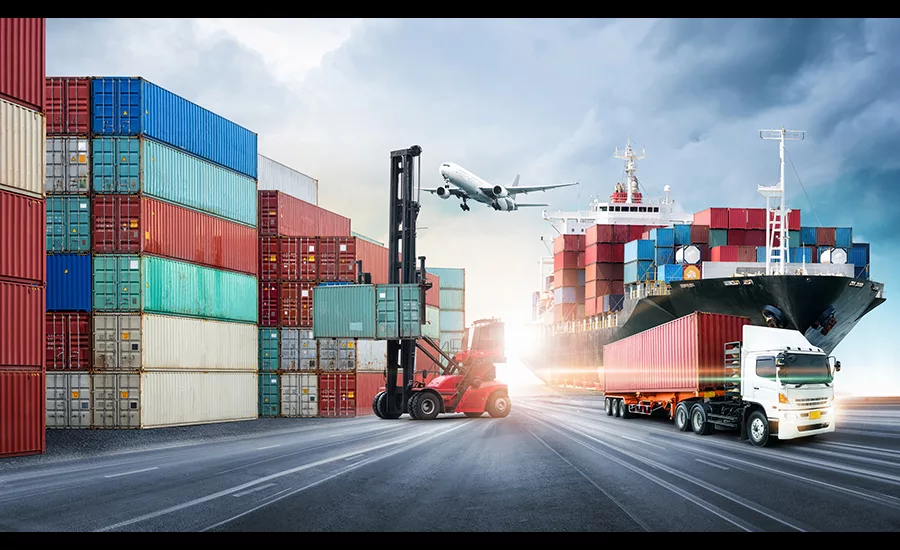Tech tools to help processors make sense of today’s supply chain
Supply chain hurdles created by COVID-19 provide an opportunity to attack deficiencies with the latest technology

Photo courtesy of Getty Images/Tryaging
During Johnny Carson’s 30-year run as host of the Tonight Show (1962–1992) his character Carnac the Magnificent would frequently predict the answer to a question hidden in sidekick Ed McMahon’s secret envelope. For the last two years of the COVID-19 pandemic, food processors could have used some of Carnac’s magical insight—in this case, finding causes and solutions to certain supply chain failures.
Back in 2007, FE looked at tools—e.g., forecasting, scheduling and others—that could help processors get a better grip on their product flow and supply chains. Fifteen years ago, these tools, which may have been standalone or part of an ERP system, were not all that well connected or intuitive. Today’s tools are integrated through standards and smarter, because there’s more computing power behind the artificial intelligence (AI) that can learn how your supply chain works and make recommendations to keep ingredients and products flowing smoothly.
While we hope the COVID-19 pandemic is fading into the background, we still need to be concerned with labor shortages, transportation interruptions, political issues, weather extremes, and other peripheral circumstances that can still break critical links in the supply chain.

Longer vs. shorter, international vs. regional/local
“The sprawling and rigid nature of many food and beverage businesses’ supply chains certainly led to complications during the pandemic,” says Jack Payne, Aptean solution consulting director, food and beverage. “In particular, those organizations that operate internationally encountered difficulties, as the differences in lockdown and transportation policies varied from country to country, causing delays and in some cases halting shipments entirely.”
According to Payne, shorter, local supply chains reduce risk and have additional merits. Relying more on local suppliers not only serves the purpose of reducing risk along the way, it also lessens the environmental impact of material transportation by limiting the distance between stops. What’s more, many consumers are attracted by brands that can claim their ingredients come from nearby regions, as those products are seen as more wholesome and sustainable.
Ara Surenian, VP of product management at Plex Systems, points out two primary supply-chain issues created by COVID-19. The first was related to delays and general unavailability of supply, and the second was the lack of labor to help meet demand. “The two together caused a ‘bull-whip effect’ where supply shocks cascaded up and down the supply chain,” says Surenian. Long supply lead times and logistical issues compounded the problem causing businesses to look to local suppliers to shorten lead times and improve responsiveness. This was a challenge for companies without the requisite tool kits and expertise to overcome these obstacles, adds Surenian.
“I don’t think anyone could have predicted the drastic impact COVID-19 had on supply chains and the consumer demand relative to the upstream consequences, but it did heighten any gaps food manufacturers may have had in their supply chain exponentially,” says Clay Gentry, president, transportation management division, Transportation Insight. Contingency planning became more important than ever, especially with processing or warehouse closures due to COVID-19. Companies with single plants and transportation methods weren’t nimble enough to pivot resources to another facility, so processors realized they needed backup options at every level, according to Gentry.
A case for standard
Industry has been adopting GS1 Standards since the advent of the UPC barcode more than 50 years ago. Those standards have evolved into a global system that uniquely identifies products, assets and location in the global supply chain.
By setting up products to be uniquely identified and traced using GS1 Standards, companies are reducing paper-based recordkeeping, manual labor and otherwise unorganized data. When trading partners leverage these standards, the result is a nimble operation with a real-time look into multiple layers of the supply chain—not just one partner up and one partner down the chain.
Let’s say a recall takes place—a common example of food supply chain disruption—when food products are identified with standards, businesses can easily identify those products and pinpoint what should be removed from inventory. This eliminates the category-wide recalls and ensures safe food is available for consumers.
—Liz Sertl, GS1 US
Visibility—or the lack thereof
One of the biggest supply chain issues during the pandemic has been visibility of product, location and how to shift from point A to point B quickly, says Liz Sertl, senior director, GS1 US. Without end-to-end visibility into the supply chain, it’s hard to pinpoint exactly where product is at all times. When supply chains are identifying, capturing and sharing product and location data in a standardized way, businesses can quickly be made aware of what supply chain issues may be occurring and adjust appropriately.
“We saw that food companies, which had visibility of the supply chain and demand, could handle the disruptions better than their peers,” says Marcel Koks, Infor senior director, industry & solution strategy, food & beverage. “They could immediately see the impact of the demand switching from foodservice to retail, or the impact of having to shut down a distribution center because of infected workers. Surprisingly, most food companies I talked to didn’t have major issues with the sourcing of ingredients at the beginning of the pandemic, mostly because there were high buffers. But it had a high cost, and the number of shortages and costs currently are increasing.”
Tools to increase visibility, minimize risk
For tech tools to work correctly, there should be data standardization so software providers don’t have to spend their time translating data to fit certain requirements. With standardized data, the need for cross-reference tables and manual intervention is minimized, says Sertl. Global Trade Identification Numbers (GTINs) and Global Location Numbers (GLNs) need to be leveraged to ensure optimal supply chain visibility and interoperability between all trading partners, as those are fundamental for success.
While having these data standards is crucial, the pandemic showed processors and shippers that they need to understand their data gaps, says Gentry. Many companies didn’t have the data relative to their business along with third-party data to inform better forecasting and risk analysis. All of those are important factors to mitigate potential financial loss.
“On the transportation side, we have seen specifically the impact of lack of drivers and equipment, resulting in constraints on overall carrier capacity,” adds Gentry. “This has resulted in drastic increases in transportation costs, which can erode already tight margins.”
Demand and forecasting tools
Fifteen years ago, processors may have purchased standalone forecasting, demand planning and warehouse management controls, but thanks to AI and machine learning, these tools are commonly available in current ERP systems, obviating the need for separate software. In addition, most ERP companies today have specialized systems that understand the needs of processors, and in many cases, these tools can be located in the cloud or on premises.
Demand forecasting tools built into ERP can be programmed to account for historical sales data, seasonal surges and shifts in consumer forecast reports, says Aptean’s Payne. These reports can help processors see around the curve and remain competitive when changes in taste and trends affect demand. For example, models can be created based on outlier events—like blizzards in the North and hurricanes in the Southeast—which can lead to better understanding and predicting consumer buying habits in times of crisis. “While the pandemic has certainly outlasted any weather pattern, the hoarding behavior consumers exhibited at the outset of lockdowns was not unlike that which occurs prior to a serious storm,” says Payne.
Plex’s Surenian reports that some of its food processor customers have adopted formal sales and operations planning (S&OP) that include formal forecasting and demand planning tools. Through the formality of S&OP coupled with a demand planning process that includes the inclusion of market data and other information, they were able to see the shifts in their markets and move supply to meet demand. It is through this iterative process that companies can make calculated decisions and understand the potential risk relative to sales and inventory challenges, according to Surenian.
An effective ERP business planning suite makes it possible to simulate changes in the demand and the supply chain—and compare scenarios, in terms of profitability, service levels, utilization of the factories and warehouses, cost of transportation and cold stores, and much more, says Richard van der Meulen, Infor VP, solution consulting. All this is managed with an integral workflow that overarches the various departments and responsibilities in the organization. It provides S&OP and execution in one platform with a consistent and seamless user interaction. Planners can see both the plan on a tactical level and real-time operational data. This would include sales order intake and progress in manufacturing for faster and continuous planning. Financial controllers also can see the impact of changes on cash flow and profitability.
Anticipating supplier issues
To stay on top of potential disruptions in their supply chains, F&B professionals need forward and backward transparency, says Payne. “When all stakeholders can see and update a shared record, reacting to adverse events becomes more manageable, as changes made in real-time keep stakeholders informed and prepared to pivot as necessary.”
Integrated business planning ensures that demand, capacity and sourcing constraints are considered, says Infor’s Koks. A supply chain planning system should be able to match supply and demand, using linear programming to generate multiple scenarios very quickly. Such a system can consider multiple sourcing alternatives for ingredients, if these alternatives are defined as approved options. While qualified suppliers with certificates can be maintained in an ERP system, a best practice may indicate using a product lifecycle management (PLM) system as supplier changes can affect formulations, nutritional values and allergens.
There is no magic bullet on the supply side, says Plex’s Surenian. The first step is to understand which ingredients are most critical to your recipe—i.e., how much revenue are they responsible for creating. Then review suppliers for ingredients and assess their lead time and delivery performance plus other critical metrics. Supply chain planning software should have this capability. In addition, there are tools available to connect demand with supply across the supply chain, and there are also track-and-trace tools to see the delivery of orders and understand where there could be delays.
There are many variables within the food industry, which makes it critical to have alternative partners throughout the entire supply chain, says Transportation Insight’s Gentry. “It is also critical to understand your sourcing and supply chain partners’ contingency plans. Demand and markets will always evolve, but if a global pandemic has taught us anything, it is you have to have a backup plan.”
Looking for a reprint of this article?
From high-res PDFs to custom plaques, order your copy today!







